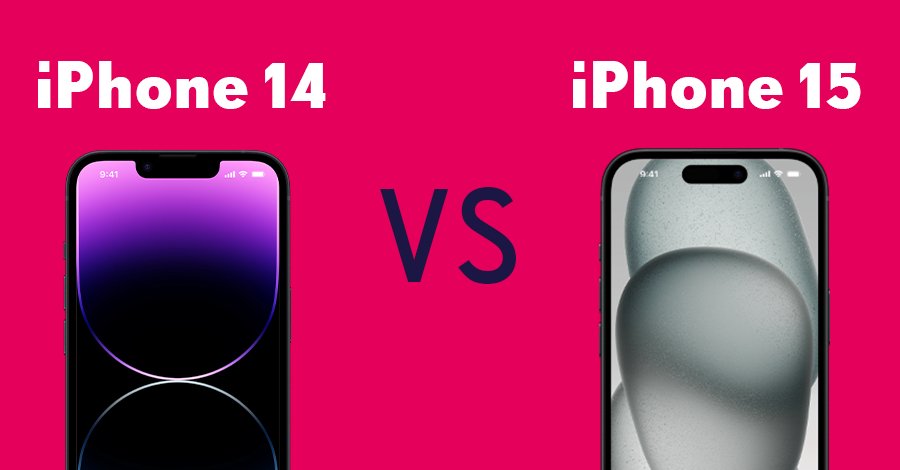Apple's annual iPhone launch is always a highly anticipated event, and this year was no exception with the unveiling of the iPhone 15, with its launch date on the 22nd of September 2023. But how does it stack up against its predecessor, the iPhone 14? In this blog post, we'll delve into the key differences between the two models to help you decide whether an upgrade is worth it.
Design and Build
iPhone 14 Series
The iPhone 14 features a blend of aluminum and glass. It is available in the colours ‘Midnight’, ‘Starlight’, ‘(PRODUCT)RED’, ‘Blue’, ‘Purple’, and the ‘all-new yellow’. The iPhone 14 features an IP68 water resistance rating, boasting a resistance of 6 meters deep for 30 minutes.
iPhone 15 Series
The iPhone 15 takes a leap forward in design innovation. It is crafted from aerospace-grade aluminium and features a new range of colour-infused glass, which boasts both durability and aesthetics. The iPhone 15 is available in 5 new muted colours: ‘Pink’, ‘Yellow’, ‘Green’, ‘Blue’, and ‘Black’. The iPhone 15 comes with a Ceramic Shield front, making it tougher than any other smartphone glass on the market. Furthermore, say goodbye to cable-clutter with a USB-C charging point.
Our verdict: The Ceramic Shield front of the iPhone 15 adds an extra layer of robustness, making it ideal for those prone to accidental drops or outdoor activities.
Display
iPhone 14 Series
The iPhone 14 features a 6.1-inch Retina display, crisp visuals and vibrant colours. However, the iPhone 14 pro offers a 6.7-inch Super Retina XDR display, offering an improvement from the base model.
iPhone 15 Series
While maintaining the same 6.1-inch or 6.7-inch Retina display, it introduces a new feature called Dynamic Island. This innovative addition enhances user interaction by displaying real-time alerts and activities without disrupting what you're doing on the screen.
Our verdict: Are you a busy mum or an avid multi-tasker? The Dynamic Island feature of the iPhone 15 is handy for those who want to stay updated without switching between apps or screens. However, if you don’t particularly love this feature, the iPhone 14 Pro also provides the same Super Retina XDR display.
Camera
iPhone 14 Series
The iPhone 14 has a 12MP primary camera that offers features like Night mode and Deep Fusion, which are impressive for everyday photography. The iPhone 14 Pro Max is better suited to avid smartphone photographers, offering 2x optical zoom capabilities and advanced computational photography features like ProRAW and ProRes video recording,
iPhone 15 Series
The iPhone 15 significantly surpasses the iPhone 15 with its photography capabilities, boasting a 48MP main camera that significantly elevates the photography experience. The camera captures super-high-resolution photos and has a 2x Telephoto lens, allowing for better zooming capabilities. The advanced portrait features offer more detail and richer colour.
Our verdict: If photography is a significant part of your life, professionally or as a hobby, upgrading to the iPhone 15 would be highly beneficial. The higher resolution, Telephoto lens, and advanced portrait features are compelling reasons to make the switch. However, if you're a casual photographer and the camera isn't a deal-breaker for you, the iPhone 14 still offers decent capabilities that should suffice for everyday photography needs. However, the iPhone 14 Pro Max comprises some of the capabilities of the iPhone 15’s camera.
Performance
iPhone 14 Series
The iPhone 14 was powered by the A15 Bionic chip, which is efficient for daily tasks and some level of gaming. However, the A15 Bionic chip in the iPhone Pro Max offers improved optimisation for better performance in specific areas like advanced photography and video recording.
iPhone 15 Series
The iPhone 15 steps up the game with its A16 Bionic chip, which powers various advanced features. These include computational photography for capturing 24MP photos and next-gen portraits, as well as voice isolation for clearer phone calls. The chip also offers smooth performance for graphics-intensive games, making the iPhone 15 a powerhouse of capabilities.
Our verdict: If you frequently engage in activities that require high computational power—such as advanced mobile gaming, professional photography, or multitasking across resource-intensive apps—then the iPhone 15's A16 Bionic chip would offer a noticeable improvement. On the other hand, if you use your phone primarily for basic tasks like web browsing, social media, and casual photography, the A15 Bionic chip in the iPhone 14 should be more than sufficient. While impressive, the performance gains in the iPhone 15 may not significantly impact your day-to-day experience if you're not pushing the limits of what your device can do.
Battery Life
iPhone 14 Series
The iPhone 14 offers up to 18 hours of talk time, which is decent for daily use but requires frequent charging for heavy users or during long trips.
iPhone 15 Series
The iPhone 15, however, promises an all-day battery life and even goes up to 26 hours of video playback on the iPhone 15 Plus model. This is a significant improvement and is especially beneficial for those who are always on the go and don't want to be tethered to a charger.
Our verdict: If you're primarily using your phone for basic tasks and you're not far from a charging source most of the time, the iPhone 14's battery life might be sufficient for your needs. Upgrading solely for better battery life might not offer enough value to justify the cost.
Price
iPhone 14 Series
- iPhone 14 (6.1-inch display): From £29.12/month or £699
- iPhone 14 Plus (6.7-inch display): From £33.29/month or £799
iPhone 15 Series
- iPhone 15: From £33.29/month or £799
- iPhone 15 Pro: From £41.62/month or £999
Our Conclusion
Choosing between the iPhone 14 and the iPhone 15 can be a challenging decision, especially when both phones offer compelling features. However, each model serves different needs and preferences, making the choice easier depending on your priorities. The iPhone 14 Pro Max provides a middle ground for those who want advanced features but aren't quite ready to make the leap to the iPhone 15. Its A15 Bionic chip, optimised for better performance in specific areas like advanced photography and video recording, makes it a robust choice for power users who don't necessarily need the latest and greatest. Click here to check out our refurbished iPhone 14 Pro Max choices.

